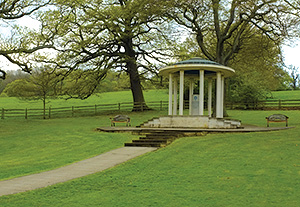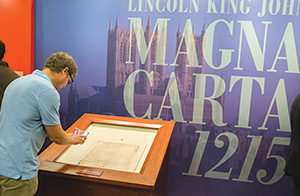By Mark F. Bernstein '89
(UVA Lawyer)
Now here’s a client meeting for you. In June 2017, Suzelle Smith ’83 met with Olivia de Havilland, the 102-year-old, two-time Oscar-winning best actress, most widely known as Melanie from “Gone with the Wind.” Smith had known de Havilland for more than 25 years and had advised her on some legal matters, but this was more of a social call.
Over champagne and canapés in de Havilland’s Paris apartment, Smith brought up “Feud: Bette and Joan,” the docudrama about actresses Bette Davis and Joan Crawford produced by FX Network. The show depicted de Havilland as a foul-mouthed gossip.
“I asked her,” Smith said via email, “as the only living person who participated in the real events: (1) Did you help in the writing of ‘Feud’; (2) did you consent to FX using your name and persona; and (3) did you say those things portrayed in the film?”
“No, no and no — can we sue?” de Havilland replied. So sue they did.
Their claim, alleging that the show’s creators portrayed de Havilland in a false light and used her likeness without compensation, provoked opposition from some of Hollywood’s big hitters, including the Motion Picture Association of America. Although the trial court denied a defense motion to dismiss the claim, the state court of appeals reversed in what Smith described as a “pro-industry” decision. The California Supreme Court, with one published dissent, declined to review that decision, and Smith filed a writ of certiorari with the U.S. Supreme Court in October.
Though perhaps the most colorful, the case is hardly the only high-profile matter Smith has handled since founding her Los Angeles–based firm, Howarth & Smith, in 1985. She has represented professional football players in an antitrust suit against the NFL, families of 9/11 victims in a suit against Osama bin Laden, and the Vatican Library in a $100 million breach-of-contract claim. The National Law Journal has named Smith one of the top 10 litigators in the United States.
That experience has helped Smith become an expert on sizing up potential cases and clients, expertise she distilled into a co-authored book, “Case Assessment and Evaluation,” and a series of web videos on Legal Counselor. The book has been very successful; more than once, Smith says, she has seen it on a judge’s shelf when she has gone into a conference.
Smith and her husband, Don Howarth, started Howarth & Smith two years after she began as an associate at Gibson, Dunn & Crutcher. Before law school, she worked on Capitol Hill as a legislative assistant to Alabama Sen. Howell Heflin. She graduated summa cum laude from Boston University and earned an M.Phil. from Oxford University. She is an honorary member of the Law School Foundation Board of Trustees.
Smith acknowledges that her petition for Supreme Court review is a longshot, but is undeterred.
“It is very important to Olivia de Havilland that we see this all the way through,” she said. “They’re going to have to shoot us dead before we give up.”















